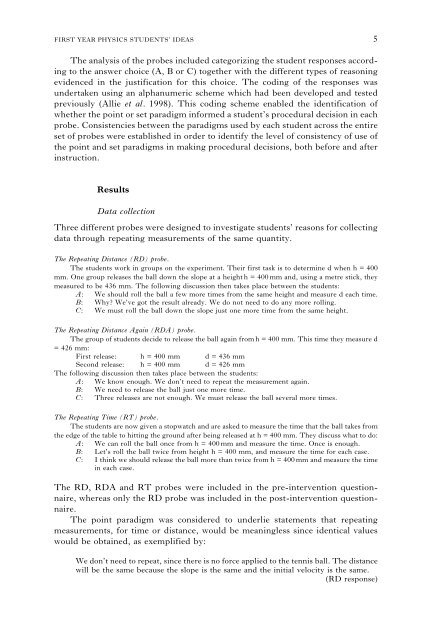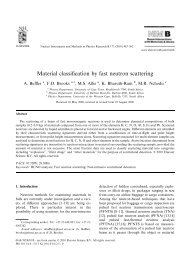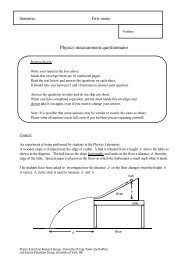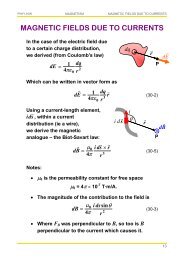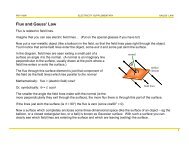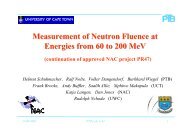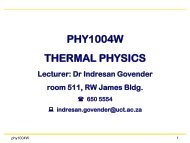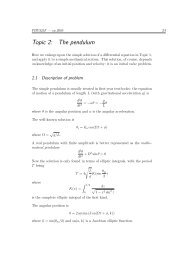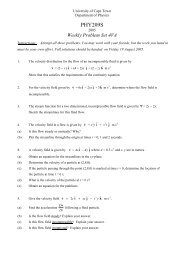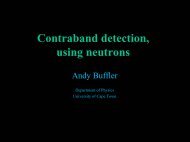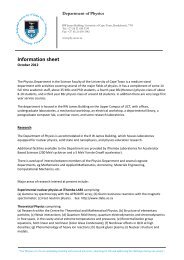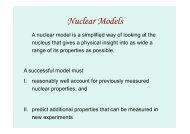ideas about measurement in terms of point and set paradigms
ideas about measurement in terms of point and set paradigms
ideas about measurement in terms of point and set paradigms
Create successful ePaper yourself
Turn your PDF publications into a flip-book with our unique Google optimized e-Paper software.
FIRST YEAR PHYSICS STUDENTS’ IDEAS 5<br />
The analysis <strong>of</strong> the probes <strong>in</strong>cluded categoriz<strong>in</strong>g the student responses accord<strong>in</strong>g<br />
to the answer choice (A, B or C) together with the different types <strong>of</strong> reason<strong>in</strong>g<br />
evidenced <strong>in</strong> the justification for this choice. The cod<strong>in</strong>g <strong>of</strong> the responses was<br />
undertaken us<strong>in</strong>g an alphanumeric scheme which had been developed <strong>and</strong> tested<br />
previously (Allie et al. 1998). This cod<strong>in</strong>g scheme enabled the identification <strong>of</strong><br />
whether the po<strong>in</strong>t or <strong>set</strong> paradigm <strong>in</strong>formed a student’s procedural decision <strong>in</strong> each<br />
probe. Consistencies between the <strong>paradigms</strong> used by each student across the entire<br />
<strong>set</strong> <strong>of</strong> probes were established <strong>in</strong> order to identify the level <strong>of</strong> consistency <strong>of</strong> use <strong>of</strong><br />
the po<strong>in</strong>t <strong>and</strong> <strong>set</strong> <strong>paradigms</strong> <strong>in</strong> mak<strong>in</strong>g procedural decisions, both before <strong>and</strong> after<br />
<strong>in</strong>struction.<br />
Results<br />
Data collection<br />
Three different probes were designed to <strong>in</strong>vestigate students’ reasons for collect<strong>in</strong>g<br />
data through repeat<strong>in</strong>g <strong>measurement</strong>s <strong>of</strong> the same quantity.<br />
The Repeat<strong>in</strong>g Distance (RD) probe.<br />
The students work <strong>in</strong> groups on the experiment. Their first task is to determ<strong>in</strong>e d when h = 400<br />
mm. One group releases the ball down the slope at a height h = 400 mm <strong>and</strong>, us<strong>in</strong>g a metre stick, they<br />
measured to be 436 mm. The follow<strong>in</strong>g discussion then takes place between the students:<br />
A: We should roll the ball a few more times from the same height <strong>and</strong> measure d each time.<br />
B: Why? We’ve got the result already. We do not need to do any more roll<strong>in</strong>g.<br />
C: We must roll the ball down the slope just one more time from the same height.<br />
The Repeat<strong>in</strong>g Distance Aga<strong>in</strong> (RDA) probe.<br />
The group <strong>of</strong> students decide to release the ball aga<strong>in</strong> from h = 400 mm. This time they measure d<br />
= 426 mm:<br />
First release: h = 400 mm d = 436 mm<br />
Second release: h = 400 mm d = 426 mm<br />
The follow<strong>in</strong>g discussion then takes place between the students:<br />
A: We know enough. We don’t need to repeat the <strong>measurement</strong> aga<strong>in</strong>.<br />
B: We need to release the ball just one more time.<br />
C: Three releases are not enough. We must release the ball several more times.<br />
The Repeat<strong>in</strong>g Time (RT) probe.<br />
The students are now given a stopwatch <strong>and</strong> are asked to measure the time that the ball takes from<br />
the edge <strong>of</strong> the table to hitt<strong>in</strong>g the ground after be<strong>in</strong>g released at h = 400 mm. They discuss what to do:<br />
A: We can roll the ball once from h = 400 mm <strong>and</strong> measure the time. Once is enough.<br />
B: Let’s roll the ball twice from height h = 400 mm, <strong>and</strong> measure the time for each case.<br />
C: I th<strong>in</strong>k we should release the ball more than twice from h = 400 mm <strong>and</strong> measure the time<br />
<strong>in</strong> each case.<br />
The RD, RDA <strong>and</strong> RT probes were <strong>in</strong>cluded <strong>in</strong> the pre-<strong>in</strong>tervention questionnaire,<br />
whereas only the RD probe was <strong>in</strong>cluded <strong>in</strong> the post-<strong>in</strong>tervention questionnaire.<br />
The po<strong>in</strong>t paradigm was considered to underlie statements that repeat<strong>in</strong>g<br />
<strong>measurement</strong>s, for time or distance, would be mean<strong>in</strong>gless s<strong>in</strong>ce identical values<br />
would be obta<strong>in</strong>ed, as exemplified by:<br />
We don’t need to repeat, s<strong>in</strong>ce there is no force applied to the tennis ball. The distance<br />
will be the same because the slope is the same <strong>and</strong> the <strong>in</strong>itial velocity is the same.<br />
(RD response)


